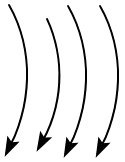A tall cylinder is filled with viscous oil. A round pebble is dropped from the top with zero initial velocity. The plot shown in the figure indicates the one that represents the velocity \((v)\) of the pebble as a function of time \((t).\)
1.

2.

3.

4.





Which of the following diagrams does not represent a streamline flow?
| 1. |  |
2. |  |
| 3. |  |
4. |  |
Along a streamline,
| 1. | the velocity of a fluid particle remains constant. |
| 2. | the velocity of all fluid particles crossing a given position is constant. |
| 3. | the velocity of all fluid particles at a given instant is constant. |
| 4. | the speed of a fluid particle remains constant. |
An ideal fluid flows through a pipe of circular cross-section made of two sections with diameters \(2.5\) cm and \(3.75\) cm. The ratio of the velocities in the two pipes is:
1. \(9:4\)
2. \(3:2\)
3. \(\sqrt{3}:\sqrt{2}\)
4. \(\sqrt{2}:\sqrt{3}\)
The angle of contact at the interface of the water glass is \(0^{\circ},\) ethyl-alcohol glass is \(0^{\circ},\) mercury-glass is \(140^{\circ}\) and methyl iodide-glass is \(30^{\circ}.\) A glass capillary is put in a trough containing one of these four liquids is observed that the meniscus is convex. The liquid in the trough is:
1. water
2. ethyl alcohol
3. mercury
4. methyl iodide
For a surface molecule,
| (a) | The net force on it is zero. |
| (b) | There is a net downward force. |
| (c) | The potential energy is less than that of a molecule inside. |
| (d) | The potential energy is more than that of a molecule inside. |
Choose the correct alterative/s:
| 1. | (b), (c) | 2. | (b), (d) |
| 3. | (c), (d) | 4. | (a), (d) |
A wooden block with a coin placed on its top, floats in water as shown in the figure.
The distances \(\mathrm{l}\) and \(\mathrm{h}\) are shown in the figure. After some time, the coin falls
into the water. Then,
| (a) | \(\mathrm{l}\) decreases |
| (b) | \(\mathrm{h}\) decreases |
| (c) | \(\mathrm{l}\) increases |
| (d) | \(\mathrm{h}\) increases |
Choose the correct alterative/s:
| 1. | (b), (c) |
| 2. | (a), (d) |
| 3. | (c), (d) |
| 4. | (a), (b) |
| (a) | gases decrease. | (b) | liquids increase. |
| (c) | gases increase. | (d) | liquids decrease. |
Which of the following options is/are correct?
| 1. | (b), (c) | 2. | (a), (d) |
| 3. | (c), (d) | 4. | (a), (b) |
Streamline flow is more likely for liquids with,
| (a) | high density. | (b) | high viscosity. |
| (c) | low density. | (d) | low viscosity. |
Choose the correct option:
| 1. | (a), (b) | 2. | (c), (d) |
| 3. | (b), (c) | 4. | (a), (d) |
A liquid does not wet the solid surface if the angle of contact is:
1. equal to \(45^{\circ}\)
2. equal to \(60^{\circ}\)
3. greater then \(90^{\circ}\)
4. zero







